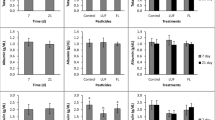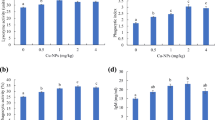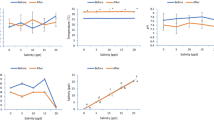Abstract
The aim of this study was to explore the effects of lead exposure on the antioxidant and immune responses of Crucian carp. Three hundred sixty healthy Crucian carp were randomly grouped into four groups and exposed to different doses of lead (0, 0.05, 0.5, and 1 mg/L). Fish were sampled at 30 and 60 days, respectively, and antioxidant capability, immune parameters, ALAD activity, and immune-related genes were assessed. The results showed that T-AOC and GSH activities of the liver were significantly increased in 60 days (P < 0.05); the activities of SOD, CAT, T-AOC, and GSH were significantly increased (P < 0.05) compared to the control in the kidney in 60 days. With an increase in Pb dose, the activity and expression of lysozyme and the content of immunoglobulin M were significantly decreased compared to the control. Compared with the control group, the activity of ALAD in the lead-exposed group decreased significantly (P < 0.05). The expression of the HSP70, tumor necrosis factor-α (TNF-α), interleukins (IL-10), and immunoglobulin M genes was all enhanced in lead-exposed group, whereas lysozyme gene expression was decreased. The results indicated that lead induced oxidative stress and had immunotoxic effects on Crucian carp.




Similar content being viewed by others
References
Arulkumar A, Paramasivam S, Rajaram R (2017) Toxic heavy metals in commercially important food fishes collected from palk bay, southeastern India. Mar Pollut Bull 119(1):454–459
Burgos MG, Rainbow PS (2001) Availability of cadmium and zinc from sewage sludge to the flounder, platichthys flesus, via a marine food chain. Mar Environ Res 51(5):417–439
Wu YS, Huang SL, Chung HC, Nan FH (2017) Bioaccumulation of lead and non-specific immune responses in white shrimp (litopenaeus vannamei) to Pb exposure. Fish Shellfish Immun 62:116–123
Fang L, Zhao F, Shen X, Ou YW, Liu X, Xu Y, Yu T, Jin B, Chen J, Luo W (2012) Pb exposure attenuates hypersensitivity in vivo by increasing regulatory t cells. Toxicol Appl Pharmacol 265(2):272–278
Yi YJ, Zhang SH (2012) Heavy metal (Cd, Cr, Cu, Hg, Pb, Zn) concentrations in seven fish species in relation to fish size and location along the Yangtze River. Environ Sci Pollut Res 19(9):3989–3996
Mahalakshmi M, Balakrishnan S, Indira K, Muthukumarasamy S (2012) Characteristic levels of heavy metals in cannes tuna fish. J Toxicol Environ Health Sci 4(2):43–45
Landrigan PJ, Boffetta P, Apostoli P (2000) The reproductive toxicity and carcinogenicity of lead: a critical review. Am J Ind Med 38:231–243
Grosell M, Mcdonald MD, Walsh PJ, Wood CM (2004) Effects of prolonged copper exposure in the marine gulf toadfish ( opsanus beta ) ii: copper accumulation, drinking rate and na+ /k + −atpase activity in osmoregulatory tissues. Aquat Toxicol 68(3):263–275
Dai W, Liu S, Fu L, Du H, Xu Z (2012) Lead (pb) accumulation, oxidative stress and dna damage induced by dietary pb in tilapia (oreochromis niloticus). Aquac Res 43(2):208–214
Dragun Z, Krasnići N, Strižak Z, Raspor B (2012) Lead concentration increase in the hepatic and gill soluble fractions of European chub (squalius cephalus)—an indicator of increased pb exposure from the river water. Environ Sci Pollut Res 19(6):2088–2095
Ahmed MS, Bibi S (2010) Uptake and bioaccumulation of water borne lead (pb) in the fingerlings of a freshwater cyprinid, catla catla l. J Anim Plant Sci 20(3):201–207
Kim JH, Kang JC (2017) Effects of sub-chronic exposure to lead (pb) and ascorbic acid in juvenile rockfish: antioxidant responses, mt gene expression, and neurotransmitters. Chemosphere 171:520–527
Eroglu A, Dogan Z, Kanak EG, Atli G, Canli M (2015) Effects of heavy metals (Cd, Cu, Cr, Pb, Zn) on fish glutathione metabolism. Environ Sci Pollut Res Int 22(5):3229–3237
Sandhir R, Julka D, Gill KD (1994) Lipoperoxidative damage on lead exposure in rat brain and its implications on membrane bound enzymes. Pharmacol Toxicol 74(2):66–69
Dogru MI, Dogru AK, Gul M, Esrefoglu M, Yurekli M, Erdogan S, Ates B (2008) The effect of adrenomedullin on rats exposed to lead. J Appl Toxicol 28(2):140–146
Moreira EG, Rosa GJ, Barros SB, Vassilieff VS, Vassillieff I (2001) Antioxidant defense in rat brain regions after developmental lead exposure. Toxicology 169(2):145–151
Kim JH, Kang JC (2016) The immune responses in juvenile rockfish, sebastes schlegelii for the stress by the exposure to the dietary lead (ii). Environ Toxicol Pharmacol 46:211–216
Jr BR, Sizer IW (1952) A spectrophotometric method for measuring the breakdown of hydrogen peroxide by catalase. J Biol Chem 195(1):133–140
Ellman GL, Courtney KD, Jr VA, Featherstone RM (1961) A new and rapid colorimetric determination of acetylcholinesterase activity. Biochem Pharmacol 7(2):88–90
Huang C, Lai C, Xu P, Zeng G, Huang D, Zhang J, Zhang C, Cheng M, Wan J, Wang R (2017) Lead-induced oxidative stress and antioxidant response provide insight into the tolerance of phanerochaete chrysosporium to lead exposure. Chemosphere 187:70–77
Saglam D, Atli G, Dogan Z, Baysoy E, Gürler C, Eroglu A, Canliet M (2014) Response of the antioxidant system of freshwater fish (oreochromis niloticus) exposed to metals (Cd, Cu) in differing hardness. Turk J Fish Aquat Sci 14:43–52
Gutierrezalcala G, Gotor C, Meyer AJ, Fricker M, Vega JM, Romero LC (2000) Glutathione biosynthesis in arabidopsis trichome cells. Proc Natl Acad Sci USA 97(20):11108–11113
Sarkar S, Mukherjee S, Chattopadhyay A, Bhattacharya S (2017) Differential modulation of cellular antioxidant status in zebrafish liver and kidney exposed to low dose arsenic trioxide. Ecotoxicol Environ Saf 135:173–182
Olmo R, Teijón C, Muñiz E, Beneit JV, Villarino AL, Blanco MD (2012) Modulation of lysozyme activity by lead administered by different routes. In vitro study and analysis in blood, kidney, and lung. Biol Trace Elem Res 149(3):405–411
Reddy PS, Corley RB (1999) The contribution of er quality control to the biologic functions of secretory igm. Immunol Today 20(12):582–588
Halley GO (2017) Effects of standard permissible levels of lead (Pb) for potable waters on fish innate immune response and health compared with Pb levels found in natural waterbodies. Int J Bioassays 6(11):5543–5473
Kaya H, Akbulut M (2015) Effects of waterborne lead exposure in Mozambique tilapia: oxidative stress, osmoregulatory responses, and tissue accumulation. J Aquat Anim Health 27(2):77–87
Gundacker C, Gencik M, Hengstschläger M (2010) The relevance of the individual genetic background for the toxicokinetics of two significant neurodevelopmental toxicants: mercury and lead. Mutat Res Rev Mutat 705(2):130–140
Gupta SC, Sharma A, Mishra M, Mishra RK, Chowdhuri DK (2010) Heat shock proteins in toxicology: how close and how far? Life Sci 86:377–384
Sanders BM, Martin LS (1993) Stress proteins as biomarkers of contaminant exposure in archived environmental samples. Sci Total Environ 139(140):459–470
Wali A, Balkhi MH (2016) Heat shock proteins, importance and expression in fishes. Eur J Biotechnol Biosci 4:29–35
Cantinha RDS, Borrely SI, Oguiura N, Rigolon MM, Nakano E (2017) Hsp70 expression in biomphalaria glabrata, snails exposed to cadmium. Ecotoxicol Environ Saf 140:18–23
Li N, Liu F, Song L, Zhang P, Qiao M, Zhao Q, Li W (2014) The effects of early life pb exposure on the expression of 1l1-β, tnf-α and aβ in cerebral cortex of mouse pups. J Trace Elem Med Biol Organ Soc Miner Trace Elem 28(1):100–104
Valentino M, Rapisarda V, Santarelli L, Bracci M, Scorcelletti M, Di LL, Cassano F, Soleo L (2007) Effect of lead on the levels of some immunoregulatory cytokines in occupationally exposed workers. Hum Exp Toxicol 26(7):551–556
Yong H, Lee WT, Lawrence DA (1998) Differential effects of lead and camp on development and activities of th1- and th2-lymphocytes. Toxicol Sci 43(2):172–185
Flohé SB, Brüggemann J, Herder C, Goebel C, Kolb H (2002) Enhanced proinflammatory response to endotoxin after priming of macrophages with lead ions. J Leukoc Biol 71(3):417–424
Dai W, Fu L, Du H, Liu H, Xu Z (2010) Effects of montmorillonite on Pb accumulation, oxidative stress, and DNA damage in tilapia (Oreochromis niloticus) exposed to dietary Pb. Biol Trace Elem Res 136(1):71–78
Funding
This study was funded by the National Natural Sciences Foundational of China (no. 30972191), and the 948 Program from the Ministry of Agriculture of China (no. 2014Z34).
Author information
Authors and Affiliations
Corresponding author
Rights and permissions
About this article
Cite this article
Dai, J., Zhang, L., Du, X. et al. Effect of Lead on Antioxidant Ability and Immune Responses of Crucian Carp. Biol Trace Elem Res 186, 546–553 (2018). https://doi.org/10.1007/s12011-018-1316-z
Received:
Accepted:
Published:
Issue Date:
DOI: https://doi.org/10.1007/s12011-018-1316-z




